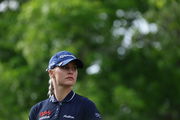
USA Today via Reuters
Sep 24, 2023; Sugar Grove, Illinois, USA; Greg Norman watches the action on the 11th green during the final round of the LIV Golf Chicago golf tournament at Rich Harvest Farms. Mandatory Credit: Jamie Sabau-USA TODAY Sports

USA Today via Reuters
Sep 24, 2023; Sugar Grove, Illinois, USA; Greg Norman watches the action on the 11th green during the final round of the LIV Golf Chicago golf tournament at Rich Harvest Farms. Mandatory Credit: Jamie Sabau-USA TODAY Sports
Pressure alone doesn’t win Augusta. Champions find clarity, commit to shots, and trust the work that built their game. At the 1987 Masters, Larry Mize, Greg Norman showed that short-game brilliance and total commitment matter more than distance. Now, decades later, he has revisited the shot and explained the strategy behind it. Speaking to young golfers at Russell Henley Jr Junior-Am lunch, he emphasized the value of practice, commitment, and the short game.
Watch What’s Trending Now!
When Larry Mize appeared at the junior-am lunch, CBS announcer Mark Immelman set the stage. He reminded the young audience of Mize’s legendary chip. With a smile, he said, “Uh, now I’m going to ask Larry to share with you guys what is arguably the greatest chip shot in the history of golf. And if your kids haven’t seen it, go to YouTube and type in “Larry Mize purple shirt.” You’ll see what I’m talking about.” That “purple shirt” moment is etched in Masters history.
It is an image of Mize sprinting across Augusta’s 11th green, celebrating his miraculous playoff chip that defeated Norman. For many fans, the shirt has become a symbol of one of golf’s greatest underdog triumphs. Mize then shifted from memory to message. Speaking directly to the juniors, he emphasized the foundation of his game.
ADVERTISEMENT
“One thing that I like to pass along to you is, you know, because we’ve all been where y’all are and want to get our games better. And I always like to encourage people to work on everything, but whatever you do, your short game can never be good enough. So always continue to work on your short game,” Mize told Mark Immelman & Russell Henley and juniors. The advice drew on decades of experience.
Mize stressed that while full swings matter, short-game mastery often separates winners from contenders. His words connected perfectly with his own career. A single chip carried him to Augusta immortality, and he now urges young players to build the same strength. He credited years of competition with his friend Les for sharpening his skills. “It’s one of the things Les and I have enjoyed—competing and practicing together with a short game, and that’s a great way to do it. But get that short game, and it’ll carry you a long way in this game.”
That philosophy is directly connected to his Masters-winning moment. Mize then walked the audience through the pressure of Augusta’s 1987 playoff. “As far as the chip shot, you know, Sandy Lyle was on number 10, and Greg Norman and I go to number 11. And I flared my shot out to the right, to the left of the green on 11. And Greg Norman hits it on the right fringe. So my thinking is, I want to hit a good aggressive shot and put the pressure back on him because he’s 40 feet from the hole for birdie.”
ADVERTISEMENT
The explanation revealed his thought process under immense pressure. He framed the shot not as survival, but as an opportunity to seize momentum. His strategy was simple: apply pressure through precision, even when his position seemed less favorable. Mize then explained the mindset that defined that historic swing. Commitment mattered more than perfection, per him.
“But one of the worst things you can be in golf is indecisive. You really have to commit to the golf shot. I don’t like hitting a bad shot, so I can handle it. But what infuriates me is hitting a bad shot because I wasn’t committed to it. Bad shots are going to happen—it’s part of the game. It’s a game of misses. Whoever misses it the best and makes a touch normally wins. So I wanted to make sure I was committed to that shot.”
ADVERTISEMENT
On the 30th anniversary of his win, Larry Mize shares his personal history with #themasters. pic.twitter.com/tVPeiicZhz
— The Masters (@TheMasters) April 9, 2017
Mize also detailed the technical challenge. Augusta’s surfaces demanded touch, not brute force. “One of the great things about it was, you practice the little pitch and run a lot at Augusta because you’ve got the tight, dry grass around the range. Sometimes you can’t fly it onto the green—they’re fast. And that was the situation of that shot there. So I had to play a little pitch and run. I had to use a 56-degree sand wedge, which is all we used back in those days. Because anything with less loft would have run into the crowd.”
That choice reflected experience and composure. A lower, running shot gave him control and kept the ball in play. It also matched the tight, fast Augusta turf, which punished hesitation. Mize trusted the club, trusted the strike, and trusted the roll. He then described the execution. He simplified his approach by focusing on one clear landing point.
ADVERTISEMENT
“So I played it back in my stance, hit a little pitch, and ran. I picked out a spot—because with the short game, in my opinion, you want to pick out a spot where you want the ball to land and not focus too much on the target. If you pick the spot where it lands and figure it’s going to run to the target, you want to focus on that. If you focus only on the target, sometimes you’re going to have trouble with distance control. So you want to focus on where you want the ball to land.”
That philosophy revealed his short-game discipline. Instead of gambling on distance, he trusted a precise spot and visualized the roll. Finally, he recalled the unforgettable result. “I did that, landed it just short. I knew it was going to go right to left. Trying to put pressure back on Greg, and sure enough, it went in—and I went running around screaming like that.” This is how his run across Augusta’s 11th green became the “purple shirt” celebration still replayed today.
The lesson endures decades later. Champions aren’t made by distance alone. They are made by belief, clarity, and the courage to commit when it matters most.
ADVERTISEMENT
Top Stories
Pro Suffers Disqualification at PGA Tour Q-School After Several Players Withdrew Abruptly

Support Pours In From Phil Mickelson as ASU Football Coach Chokes Back Tears in Public

Jason Day Opens Up About Going Through Traumatic Childhood Just to Play Golf: ‘It Was Tough’

Tom Brady & Co. ‘Misunderstood’ Scottie Scheffler After He Picked Family Over Golf Career – Insider

Charley Hull Opens Up on Traumatic Divorce from Ex-Husband for the First Time Ever

Why Short-Game Mastery Still Outshines Distance in Modern Golf
Today’s game may idolize distance, but precision often wins the day. ShotScope data confirms scoring depends more on proximity to the green than sheer tee-to-green power. That means wedges and creativity still outperform raw yardage. Recent winners back this wisdom.
At The Open, Brian Harman, far from the Tour’s longest driver, triumphed through finesse, not muscle. His short-game dominance and smart play underscored how control, not strength, wins majors in the modern era. History echoes the same truth.
ADVERTISEMENT
In the 1930s, Paul Runyan, nicknamed Little Poison, beat taller rivals with unmatched short-game skills. He showed that distance meant little if touch and accuracy stayed sharper. Golfers themselves reinforce the point. Gene Littler once said, “Golf is not a game of great shots. It’s a game of the best misses.” His words remind players that recovery and precision shape outcomes more than sheer power.
Modern stars agree. Jordan Spieth has repeatedly credited his wedge play and putting as keys to winning majors, insisting, “Short game is everything. It saves rounds, and it wins tournaments.”
The lesson stays constant across generations. Whether in Runyan’s era, Mize’s miracle at Augusta, or Spieth’s victories, short-game mastery continues to outshine distance. Champions know power fades, but precision always holds up under pressure.
ADVERTISEMENT
ADVERTISEMENT
ADVERTISEMENT
ADVERTISEMENT

